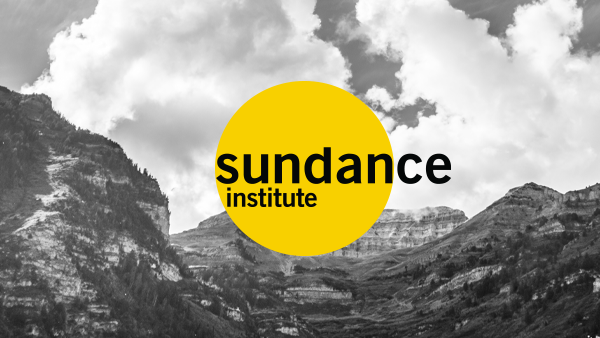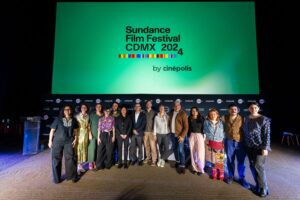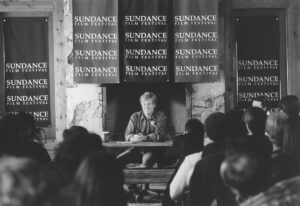Sundance Institute
Sundance.org is dispatching its writers to daily screenings and events to capture the 10 days of festivities during the Sundance Film Festival in Park City, Utah. Check back each morning for roundups from the previous day’s events.
Music and Film: The Creative Process
By Jeremy Kinser
Many of the most highly regarded filmmakers at this year’s festival crowded the Sundance House stage with their composers for “Music and Film: The Creative Process,” a panel discussion on the process of scoring film music. Twenty-seven panelists, including Peter Gloub, director of Sundance’s Composers Lab, and Blake Neely, Sundance Institute Composers Lab Advisor, sat on the annual panel, which moderator Doreen Ringer-Ross, BMI vice president of film/TV relations, described as the Festival’s biggest yet.
Ringer-Ross first asked the panelists to share stories of how they connected with one another.
“I put an ad on Craigslist for babysitters,” said Escape From Tomorrow helmer Randy Moore on how he met composer Abel Korzeniowski. The remark drew titters from the audience, until they realized he was serious. Moore explained that the Polish-born composer and his wife had just relocated to Los Angeles. Nina cared for Moore’s children and introduced him to Korzeniowski. The filmmaker noted that she continued to baby-sit for his children until Korzeniowski received his second Golden Globe nomination.
Discussing creative directives issued to the composers, Austenland’s Jerusha Hess said she begged composer Ilan Eshkeri to just make the score funny. “Please, please sell these jokes,” she recalls saying to him.

Dustin O’Halloran’s score for Drake Doremus’ Breathe In is one of the romantic drama’s most highly praised elements. The composer, a popular recording artist in his own right, compared the process to making a solo album. “It was just about searching for the right mood and emotions,” he recalled.
God Loves Uganda’s Roger Ross Williams remembered that his main concern with the score to his documentary about Evangelicals in Africa was that composer Mark De Gli Antoni avoid using stereotypical African music. “I wanted to avoid clichés,” he recalled. De Gli Antoni added that the director wanted the score to be emotional and not “too on the nose.”
Lili Hayden, composer of Anita, the documentary about Anita Hill, explained that “information hits the head and music hits the heart.” Whatever we do, we’re there to make people feel something.” She explained that in the film it’s revealed that Hill was at once time on track to become a Supreme Court Justice. “Her whole life was derailed with her courage to speak the truth and I knew that that needed to have heart,” Hayden offered. “Just one note with the right tone just gave you an extra note to feel something.”
Veteran composer Terrence Blanchard explained that working on the documentaries he made with Spike Lee, the music wasn’t required to be scene-specific. “It’s more about the overall story you’re trying to tell,” he shared. “The technical challenge for me is to enhance the narrative but to stay out of the way of the story.” He also advised composers to leave their egos at the door. “This isn’t about you,” he said. “This is about helping someone tell their story.”
We Steal Secrets: The Story of WikiLeaks
By Eric Hynes
“We thought it was a classic David and Goliath story,” director Alex Gibney said about the project that became We Steal Secrets: The Story of WikiLeaks, and which screened at Redstone Cinemas on Wednesday. “But like any story it leads you to unexpected places.” Gibney starts with the phenomenon of Julian Assange, the Australian hacker whose WikiLeaks website published classified American documents and became a lightning rod throughout the first Obama administration. He also looks into the story of Bradley Manning, an American soldier who passed along thousands of classified documents to Assange, and who still hasn’t been brought to trial three years after his arrest.

But what took Gibney by surprise was what he and his team found in Sweden. Soon after WikiLeaks partnered with The Guardian UK and the New York Times to release the first batch of classified U.S. governmental documents, two accusations of rape were levied against Assange in Sweden, which is where he was lately based. Assange and his supporters insisted that the accusations had no basis, and that they were the result of a smear campaign by the U.S. “I assumed going in that it was some kind of a stunt,” Gibney said. “The timing seemed so preposterous.” But when he looked deeper, and especially after he interviewed one of the accusers, his assumptions changed. Though unwilling to determine either guilt or innocence, he was now certain that “this isn’t a ridiculous case.” Though WikiLeaks doesn’t even have an active website, and Assange has become little more than a paranoid hermit hiding out at the Ecuadorian embassy in England, the issues raised by the film seemed to resonate with the audience, and likely means that the WikiLeaks debate will spread into movie theaters throughout the coming year.
Volunteer Appreciation Party
By Jeremy Kinser
As the sun set on Day Seven of the Sundance Film Festival, spirits were still exuberantly high at the Music Café, which became a sea of red and black. That’s because many of this year’s 1,840 volunteers, clad in their jackets provided by Kenneth Cole, shared stories of their favorite films, traded anecdotes, dined on free food and drinks, and generally just let their hair down as they reveled on the dance floor at the annual Volunteer Appreciation Party.
“The Wednesday of the Festival is always a day dedicated to our volunteers,” said Whitney Chaney, Sundance Institute’s volunteer manager. “We have a video vignette [Heroes Don’t Wear Capes, starring Alan Cumming, Rachel Dratch, and Ed Burns] we play before screenings that day that thanks them. To cap the day we have a party that is only for them with food, drinks, and dancing to show our appreciation for all the hard work they’ve put in.”

The party is just one of the many ways Sundance honors the men and women who donate their time to help make the Festival such a positive experience for everyone. Each year one person is named “Volunteer of the Year” for having exemplified what it means to be a volunteer, in terms of giving back and connecting the audience with the artists. The winner is recognized on the first day of the festival in acknowledgement of work during the previous year.
“We get nominations from volunteers and staff and anyone involved with the Festival,” Chaney shared. “We take them to the board and get their input.”
The award is presented annually on Day One of the Festival in honor of Gail Stevens, a longtime volunteer and member of the Utah Advisory Board, who passed away in 2008.
On January 17, Shirley Olson, a 22-year veteran of Sundance’s volunteer program and a 7-year film office veteran, was surprised with the honor. Olson says the commendation was particularly poignant for her as she and Stevens had been friends and Stevens’ husband presented the award.
“It was so meaningful to me because I knew Gail,” Olson shared at the party. “She was such a supporter of the arts and Sundance and its volunteers.”
Olson says she first volunteered in 1989 because she thought it would be a good way to meet people and see what’s going on in the art scene in Utah, and her daughter would later join her as a volunteer for three years.
Olson compares the yearly experience to attending summer camp. “I do it because I like to reconnect with my friends each year and I believe in the mission of Sundance and what they’re doing to promote independent filmmaking,” she added. “Sundance treats us so well. They really do care that their volunteers are content and happy and that things are working for them. The supervisors are very conscious of making it a good experience for the volunteers and a real camaraderie develops. I think that’s why people come back.”
BMI Snowball Concert
By Eric Hynes
The spirit of Alabama was alive and well in Park City on Wednesday night for the BMI Snowball Concert at Sundance House, presented by HP. In honor of Festival film Muscle Shoals, which tells the story of the fabled recording studio and town of the same name, this year’s concert was comprised of musical acts from the studio and surrounding region.
“The Native Americans who lived there believed that the river sang songs to them,” said director Greg “Freddy” Camalier. “It was the birthplace of Sam Phillips and W.C Handy, and it was the home to seminal music that has been a part of lot of y’alls lives, from soul to rhythm and blues to southern rock to rock n roll to country.” Camalier started things off by introducing songwriting legends Dan Penn and Spooner Oldham. With Penn on guitar and Oldham on the organ, they played their hits “I’m Your Puppet” and “Sweet Inspiration,” songs that were famously recorded by the likes of Marvin Gaye, Sam & Dave and Dionne Warwick, yet came alive anew in Penn’s soulful tenor and Oldham’s rough and delicate harmony. “I don’t know how good the film is,” Penn said of the documentary in which he appears, and which will have its World Premiere on Saturday afternoon. “But it looked like they had the right camera.”
Next up was Percy Sledge, the Leighton, Alabama native whose unmistakable gap-toothed smile and bring-the-house-down performance style seemed unchanged from his 1960s heyday. Accompanied on guitar by John Paul White of the band The Civil Wars, Sledge sang the Penn classic “At the Dark End of the Street,” and the song he referred to as his “bread and butter,” the showstopper “When a Man Loves a Woman.” “I made the melody up when I was picking cotton in the field,” Sledge said. “I sang it all through my life, and had no idea it would mean so much to me. I want to thank my god for letting me sing my song for so many years.” From the looks the room alighted by smartphones capturing the moment, Percy wasn’t the only one who was thankful.




